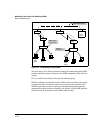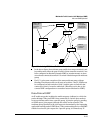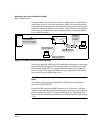
Multimedia Traffic Control with IP Multicast (IGMP)
More on IGMP Operation
Then the switch does not need to wait for the Querier status update interval,
but instead immediately removes the IGMP client from its IGMP table and
ceases transmitting IGMP traffic to the client. (If the switch detects multiple
end nodes on the port, automatic Fast-Leave does not activate—regardless of
whether one or more of these end nodes are IGMP clients.)
In the next figure, automatic Fast-Leave operates on the switch ports for IGMP
clients “3A” and “5B”, but not on the switch port for IGMP clients “7A” and 7B,
Server “7C”, and printer “7D”.
Routing
Switch
Acting as
Querier
Series 5300XL switch
Server
7C
Switch 7X
3A
5A
7A
Fast-Leave IGMP
automatically operates on
the ports connected to
IGMP clients 3A and 5A,
but does not operate on
the port connected to
Switch 7X because the
Series 5300XL switch
detects multiple end
nodes on that port.
Fast-Leave IGMP does
not activate on this port.
Fast-Leave IGMP
activates on these
two ports.
1 5
7
Printer
7D
7B
3
Figure 12-6. Example of Automatic Fast-Leave IGMP Criteria
When client “3A” running IGMP is ready to leave the multicast group, it
transmits a Leave Group message. Because the switch knows that there is only
one end node on port 3, it removes the client from its IGMP table and halts
multicast traffic (for that group) to port 3. If the switch is not the Querier, it
does not wait for the actual Querier to verify that there are no other group
members on port 3. If the switch itself is the Querier, it does not query port 3
for the presence of other group members.
Note that Fast-Leave operation does not distinguish between end nodes on
the same port that belong to different VLANs. Thus, for example, even if all of
the devices on port 7 in figure
12-6 belong to different VLANs, Fast-Leave does
not operate on port 7.
12-17


















